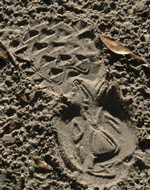- 01: Introduction
- 02: History
- 03: Propellants, Firearms, and Ammunition Development
- 04: Modern Firearms Manufacture
- 05: Small Arms Ammunition
- 06: Evidence Handling Procedures
- Introduction
- Objectives
- AFTE Knowledge and Ability Factors
- Types of Evidence
- Associative Evidence
- The Crime Scene
- Evidence Submission
- Laboratory Evidence Handling
- Case Tracking Within the Laboratory
- Firearm and Toolmark Examination Considerations
- Selected Bibliography
- 07: Equipment and Instrumentation
- 08: Examination of Firearms
- 09: Cartridge and Shotshell Examination
- 10: Characterization and Evaluation of Fired Projectiles
- 11: Bullet Comparison and Identification
- 12: Gunshot Residue and Distance Determination
- 13: Toolmark Identification
- 14: Communicating Results
- Resources


Physical Evidence
Home > Evidence Handling Procedures > Types of Evidence > Physical Evidence

Hair evidence

Footwear impression
Physical evidence refers to a wide range of physical objects (often minute in size).
Examples of physical evidence include
- firearms and fired ammunition,
- fingerprints,
- toolmarks, tire tracks, and footwear impressions,
- hairs, fibers, glass, paint, and other trace evidence.
Physical evidence may be considered as
- corroborative evidence, which tends to confirm or support the theory of the crime,
- circumstantial evidence, which indirectly infers a particular conclusion regarding the crime.




